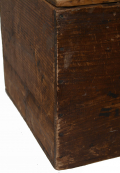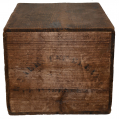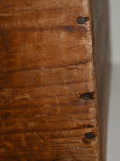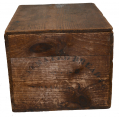site search
online catalog
“SOFT TACK:” AERATED BREAD CRATE
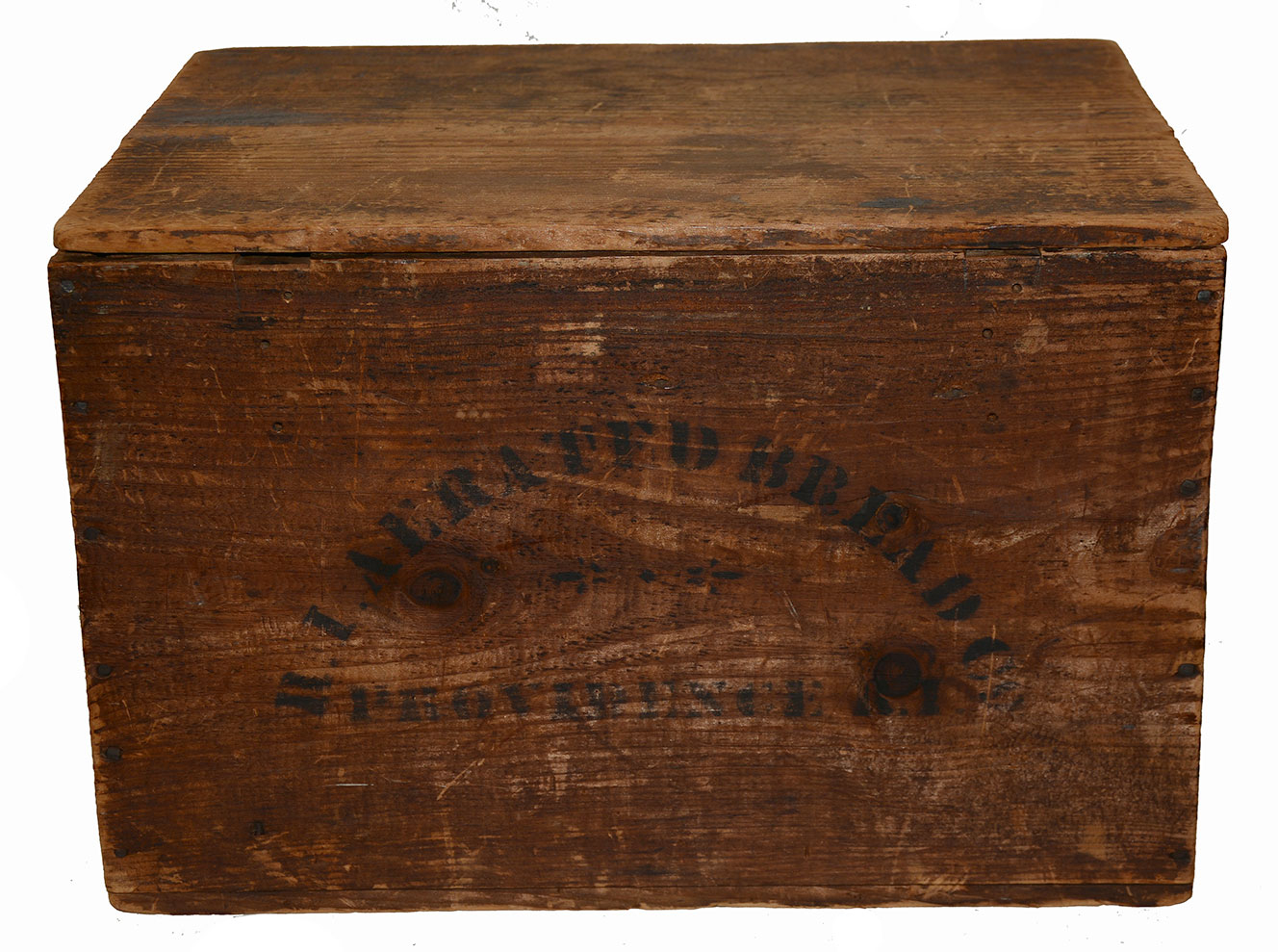
$3,950.00
Quantity Available: 1
Item Code: 1202-166
Shipping: Determined by Method & Location of buyer
To Order:
Call 717-334-0347,
Fax 717-334-5016, or E-mail
This would make a nice addition to a camp, sutler, Sanitary Commission or even a hospital display. Constructed of thin, about ½” thick, unpainted, wide pine boards that are simply nailed together, this is about 18” X 13 ¾” X 12” and is complete with lid and narrow runners on the bottom. It is stenciled in black on three sides, worn on two, but very legible on one long side: “R.I. AERATED BREAD CO.” in an arc over “PROVIDENCE R.I.” with just some wear on the “O” of “CO” and a stain in the middle of “R.I.”
This company shows up on the tax rolls as early as 1863. It must have been founded not long before. “Aerated bread” had just recently been invented in Britain by Dr. John Dauglish, who patented it in 1856, published a paper on it in 1859 and founded his own aerated bread company in 1862. Essentially, the system used carbon dioxide to leaven the bread without yeast, saving time and labor by relying on mechanical means, reducing cost, and also increasing sanitation since workers had previously been kneading bread by hand, and by foot. The Rhode Island Aerated Bread Company was situated at 65 Hospital Street in Providence, and was bought out by Providence Union Baking Company, which formed in 1867, giving an upper date for the crate.
Civil War collectors will be familiar with the army hard bread or “hardtack” supplied to soldiers on campaign and famous for its resilience, to use a kind word. Troops in camp or near larger cities, however, might well expect something a little more palatable, as would recruiting depots, points of rendezvous and training camps that might rely on civilian contractors for their mess halls; organizations like the Sanitary Commission operating in and near camps who might be drawn to use the new invention; and, hospitals, if not relying on their own bakeries, might also be customers. Needless to say, sutlers, always on the look out for something that appeal to a soldier. See, especially, our second citation below, referring to a shipment of aerated bread intended for a New York regiment during the Peninsula Campaign.
George Breck of Battery L, 1st NY Light Artillery, writing from their camp at Baltimore mentions it in an April 5, 1862, letter to his hometown paper: “A few more words about an entirely different subject, and I will close. Have you ever heard of Aerated Bread? It has been known in New York I believe for three or four years, but I think very few persons in Rochester know anything about it. It is extensively used here, and in almost every baker’s shop you will see a sign inscribed as follows: “Requa & Co’s Aerated Bread.” Our company has been supplied with it ever since we came here, and we can speak of its superiority over all other bread we ever eat, always excepting, perhaps, “home made bread.” It is called “aerated,” on account of the air being excluded in the process of making it. The flour is first thoroughly sifted, in a room above where the oven and machinery are, and then through a hole in the floor, by means of a bag it is carried into a large iron tank in the room below, which almost reaches the ceiling. This tank is capable of holding two barrels of flour at once, with the proportionate quantity of water necessary to knead it. The dough is kneaded by machinery, there being iron arms in the tank, which stir and break it up with a rapidity and style such as no human arms could do. The tank is charged with carbonic acid gas just or in a very similar manner that soda fountains are charged, the gas causing an exclusion of the air from the tank. When the dough is properly kneaded, it is put or rather let into pound loaf tin pans from the bottom of the tank by means of a large cock, through which the dough is forced into the pans by the pressure of the gas. This cock can be turned on or off at pleasure. It requires but a little time to fill a hundred or two hundred pans, which, when filled, are put into a large brick oven and the bread is baked as other bread. It is claimed to be sweeter, healthier and much more nutritious than bread made by the old fashioned process. It is as light as a feather and white as snow. Unlike yeast bread, it is never sour. I saw some, made a year ago, and it was perfectly sweet. It preserves its freshness for days, and has been pronounced excellent when it was two or three weeks old. Of course, with all these qualities, aerated bread is just the thing required by the army. The boys of our company appreciate it. The only objection to it is this, that it is so good and sweet that the boys have declared they don’t get their full quota of bread, whereas they can eat a loaf of this when they could not eat half a loaf of bread made in the old way. But my letter must be getting tedious, so enough for the present. Yours truly, G.B.”
For its availability from sutlers and its use by medical personal we can refer to Olmstead’s “Hospital Transports, a Memoir of the Embarkation of the Sick and Wounded” dealing with the Peninsula Campaign: “Just as everything was about giving out, B. found a sutler, who told him that he had five hundred loaves of bread on board of a boat which had just arrived at Cumberland, but he had no way of getting it immediately up.
A conditional bargain was immediately struck, and the Elizabeth hastened off to Cumberland to bring up the bread. When it arrived, to our horror, it proved to be so mouldy it could not be used. B., almost crying with disappointment, started again to make a search through the exhausted sutlers' stores of the post. While doing so, he came upon a heap of boxes and barrels unopened and " unaccounted for." "What's all this ?" "Sutlers' goods." " Who owns them?" "I do. I am the sutler of the — New York, up to the front. I want to get them up there, but I can't get transportation." "What's in here?" said B. in great excitement. " Mack'rel in them barrels." "What's in the boxes?"
"That's wine biscuit. There's two barrels of molasses and a barrel of vinegar. I've got forty barrels of soft tack, too." "Where's that?" "That's one of 'em"; and B., hardly waiting for leave, seized a musket, and jammed a head off. It was aerated bread, and not a speck of mould upon it! He bought the sutler’s whole stock on the spot, and in half an hour the ladies were dealing out bread spread with molasses, and iced vinegar and water….”
“Soft tack” might be that sutler’s own coinage, but we find references to soft bread sold by sutlers in other sources as well. This crate displays very well and would make a great addition to a camp, medical or hospital display. [sr][ph:L]
Extra shipping charge required.
~~~~~~~~~~~~~~~~~~~~~~~~~~~~~~~~~~~
THIS ITEM, AS WITH ALL OTHER ITEMS AVAILABLE ON OUR WEB SITE,
MAY BE PURCHASED THROUGH OUR LAYAWAY PROGRAM.
CLICK HERE FOR OUR POLICIES AND TERMS.
THANK YOU!
Inquire About “SOFT TACK:” AERATED BREAD CRATE
For inquiries, please email us at [email protected]
Most Popular
Historical Firearms Stolen From The National Civil War Museum In Harrisburg, Pa »
Theft From Gravesite Of Gen. John Reynolds »
Selection Of Unframed Prints By Don Troiani »
Fine Condition Brass Infantry Bugle Insignia »
British Imported, Confederate Used Bayonet »
Scarce New Model 1865 Sharps Still In Percussion Near Factory New »
featured item
13-STAR CONFEDERATE FIRST NATIONAL FLAG WITH GETTYSBURG HISTORY - “GRIMES COUNTY GREYS,” CO. G, 4th TEXAS INFANTRY, HOOD’S TEXAS BRIGADE
The flag is in very good condition, with strong colors and just a few scattered small holes that do not detract. It has been archivally conserved, mounted and framed by Textile Preservation Associates and comes with their November 2020 treatment… (1179-1393). Learn More »
site search
Upcoming Events
May 16 - 18: N-SSA Spring Nationals, Fort Shenandoah, Winchester, VA Learn More »




